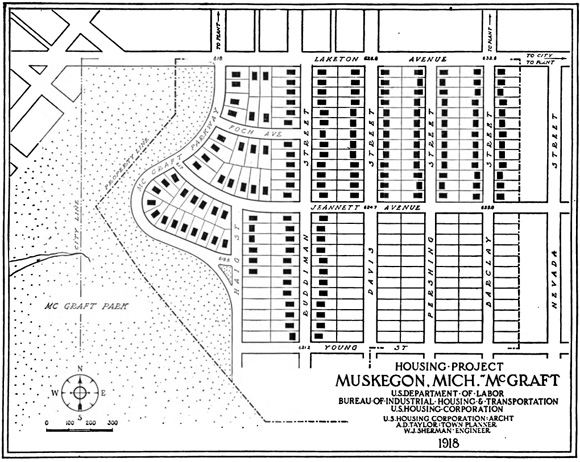Muskegon, MI
General Description (1919 report):
"Muskegon, Mich., is located on the southern shore of Muskegon Lake, a body of water 5 miles long and 2 miles wide, separated from Lake Michigan only by a ridge of sand dunes which its outlet pierces. Muskegon Heights is located inland about 3 miles south of the business district of Muskegon. The two cities have grown together and there is no boundary line between them recognizable on the ground. Muskegon has increased in population from about 20,000 in 1913 to about 40,000 in 1918, and Muskegon Heights has increased from about 3,000 to 10,000. There was a shortage of houses even before 1914 and the war work has greatly aggravated this.
"There are three groups of industries, one located in the western part of the city, one in the northeastern, and one in the southern part. It was first expected that three housing sites would have to be chosen. The principal industrial plants are Continental Motor, Lingerman Steel & Machinery Co., Brunswick, Balk, Collender co., and the Campbell Wyant Foundry. All of these were doing more of less war work..."

1919 excerpt describing the design of the Muskegon sites:
McGraft Tract - Area Planned:
45.60 acres. Housing planned: Detached houses, 248 families.
Schoenberg Tract - Area Planned, 5.19 acres. Housing planned: Detached houses, 30 families.
"The first site chosen was that known as the McGraft farm tract...This site is located in the western part of the city about three-quarters of a mile back from the lake shore. The most of the land is flat, there being, however, a precipitous slope about 20 feet high along the western side...The electric street railway line passes near one side of the development and gives very good transportation to the business district and most of the industries.
"The second site chosen was one on plotted land in Muskegon Heights known as the Schoenberg tract... There are good transportation facilities, schools, churches, and stores in the vicinity.
"The Schoenberg tract development accepted the existing streets of the town. The street arrangement of the McGraft tract also continued the existing streets, there being little excuse for any other layout on the glat upper ground; but along the edge of the valley a curved street carried through traffic on pleasant lines. The corporation bought a part of this valley and it was proposed to turn this over to the city as a park, thus contributing to connect the existing McGraft Park with our development, bringing considerable benefit both to the city and to the housing project.
"The plans and estimates had been carefully worked out in detail, and work was about to proceed when halted by the armistice. We show planting plans from this set of drawings as an example of the one way of representing wholesale planting which is simple and to be often repeated with minor variations."